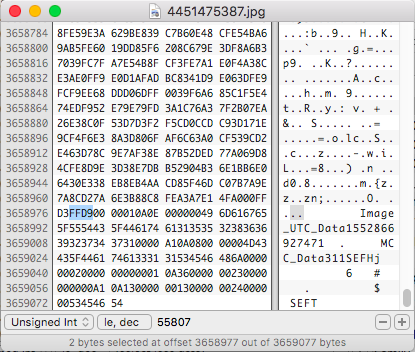If you hadn’t been over to see the posters made by Ange Albertini, head over now. Below is his poster on the JPG image file format. This is the basic JFIF file format, which stands for JPEG File Interchange Format. There are also raw JPEG streams and Exif, Exchangeable Image File Format.

The basic format is pretty straight forward. There is a start of image marker FFD8 some format information, then the raster compressed data, then an end of image marker FFD9. Identification of a JPEG file should be pretty straight forward. Knowing the start and end marker values and then the type of JPEG based on the Application data, can be very specific. That is until some software engineers start playing fast and loose with the format specifications.
A while back I received a JPG file which didn’t identify using the latest PRONOM signature. It’s happened before, some new phones came out and started using a newer version of the exif specification so I submitted an update to PRONOM for JPG’s using exif 2.3 and greater. But also may need to submit another signature soon for the newly released Exif 3.0 specification! But this JPG I received wasn’t a new version, it should have been identified with the current PRONOM signature. It started with FFD8 and when I went to look at the end of the file for the end of image marker FFD9, it wasn’t where I expected it to be.

This JPG file had an additional 9632 bytes after the FFD9 end of image marker. But why? The image rendered just fine in multiple JPG viewers. The only warning from Exiftool was for “Unrecognized MakerNotes”, which is not too uncommon. So I went to the JPG Exif specification.
EOI, Recording this marker is mandatory. It shall be recorded in this position.
But reading a little further we see…..
Moreover, Exif/DCF readers should be implemented to operate without interruption even if certain kinds of data have been recorded after EOI of the primary image defined in the Exif standard. Specifically, unknown data after EOI of the primary image should be skipped. (see section 4.7.1)
So the extra data is allowed by specification. Any readers should ignore or skip any data after the EOI (End of Image). Well that makes identification more difficult. All the PRONOM signatures are based on having the EOI marker at the “End”. Some have allowance for padding, but not enough for the worst offenders……
The image referenced above was created on a Huawei MHA-L29 cameraphone. But since finding this image, I have also found many Samsung phones do the same thing. Here is one from a Samsung SM-G975U1. Much less padding but enough to throw off identification.

Apple iPhones are also not exempt from this “feature” either. When using the MacOS ImageCapture tool with the HEIC format, a bug can add an excessive amount of empty data at the end of the converted JPG file.
So, when it comes to identification, if your JPG files don’t seem to identify correctly, look closer at the end of the file, it may have some “extra” data.
One thought on “JPG Structure”